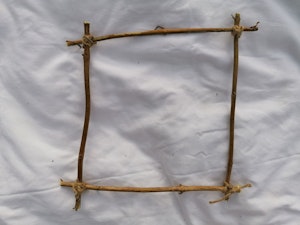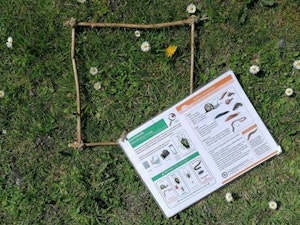Make your own quadrat
A quadrat is a simple four-sided, square-shaped device that, when placed in nature, allows you to observe and record what is happening in a specific area. This device can be used multiple times in multiple habitats, so that the results you record are always within a measured area, making your results more scientifically meaningful.
WHAT YOU WILL NEED
- Scissors
- Duct tape or similar (you can also use string but this might be trickier)
- 4 x 30cm long straight sticks or garden canes per quadrat
Optional extras for when you’re ready to use your quadrat:
- Bug pot/magnifying glass
- UK invertebrate ID sheets
- UK wildflower ID sheets/apps
- Wildlife journal or field notebook
STEP BY STEP
1. Prepare you materials
Making your own quadrat is fun but can be a bit fiddly, so make sure you’ve got all your materials prepared. It’s also a good idea to cut some lengths of tape (about 15cm) before you get started.

2. Make your corners
Take 2 of your 4 sticks and place them together in an L shape, overlapping slightly. Using a length of tape, secure your L shape together making sure you’ve wrapped the tape tightly.
When you are confident that your first corner is secure you can repeat the process to make the other 3 corners.

3. Use your quadrat
How easy was that! Now that you’ve got your very own quadrat you can go out “in the field” to test it out.
Choose a spot in your garden, balcony or outside space that you would like to observe. Gently and quietly place your quadrat down on the ground (it is important you don’t scare away any wildlife in the area that you would like to observe).

4. Record what you find
Using your free, downloadable ID sheets or maybe a wildlife app, can you record what you see in your wildlife journal? Observing nature over time builds up an exciting story of the world around you. What changes or similarities will you discover over days, weeks and months?
Top tip! You can practice using your quadrat indoors using a wildlife scene in a picture book or on a poster.
5. Share your findings
To share your findings and pictures of your nature spots, post them on CAT’s facebook page or tag @centreforalternativetechnology on instagram. #CATatHome
Email sign up
Keep up to date with all the latest activities, events and online resources by signing up to our emails and following us on social media.
